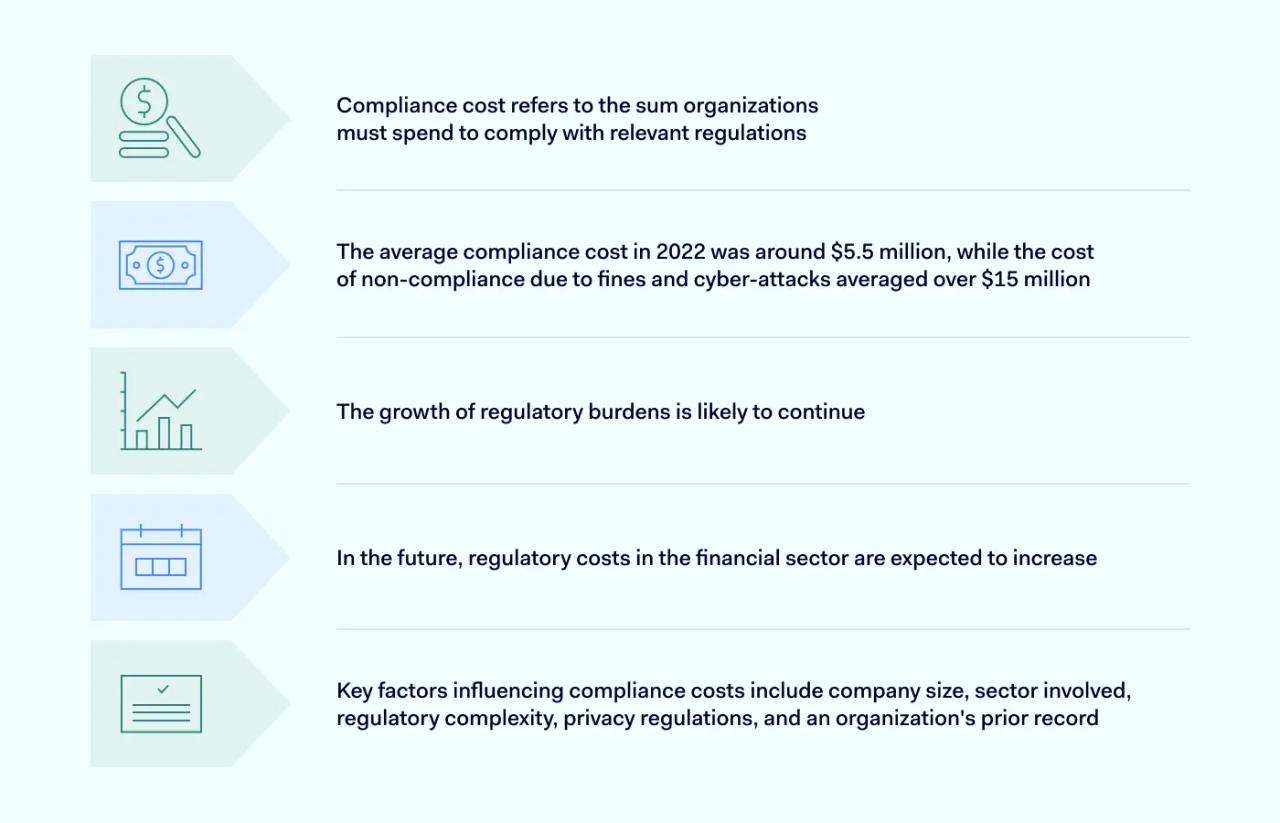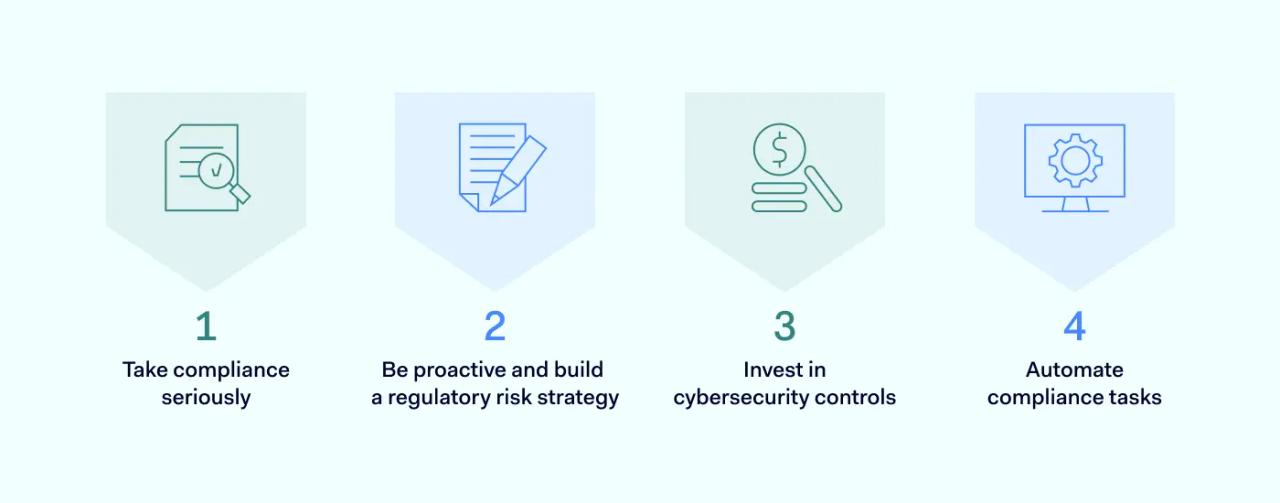Regulatory compliance is not cost-free. Companies invest heavily to secure data and ensure customer privacy. And these costs sometimes seem like a burden. But investing in compliance also has benefits. Benefits include reduced penalties and customer trust.
This article will explore the cost of regulatory compliance. We will explore how to calculate costs and what regulations require. In other words, we will understand the real cost of making businesses compliant. Read on to learn:
- What "compliance cost" means
- How to calculate overall compliance costs
- The business importance of compliance costs
- How to minimize the cost of compliance
What is a compliance cost?
A compliance cost is the sum organizations must spend to comply with relevant regulations.
The cost of regulatory compliance includes compliance audits. It also includes hiring specialist compliance officers. Companies may need to install new IT systems. They may require extra security controls. Anything that incurs an expense to meet regulatory requirements is a compliance cost.
Generally, we can divide compliance costs into a few key categories. These categories include:
- Payroll costs for compliance teams and staff training
- Technology to manage compliance processes or apply controls
- Testing to ensure that controls function properly
- Reporting and enforcement costs
- Third-party expenses and legal fees related to compliance.
How do regulatory compliance costs get assessed?
When assessing the cost of regulatory compliance, companies should minimize the cost of compliance. But they must also meet industry regulations.
Assessors calculate total costs by adding the amount spent on regulatory tasks. This calculation represents the cost of compliance management across an organization.
The first step involves understanding compliance requirements. Companies must research which regulations apply to their operations. Rules vary between sectors. For example, financial companies have a heavy compliance burden. Small merchants may have fewer issues to worry about.
Next, organizations assess the costs of investments required to become compliant. Investments could include:
- New hires to handle risk management
- Additional training for existing employees
- Tech upgrades to mitigate core risks
Calculating compliance costs also involves assessment and reporting. Companies must calculate the cost of:
- Auditing strategies to meet regulatory requirements
- Documenting risk management activity
- Producing reports or carrying out inspections
This process generates an annual figure for regulatory spending. Totals vary between industries. The average compliance cost in 2022 was around $5.5 million. This spending sounds like a significant burden. But it is only part of the story.
Companies should also factor in the cost of non-compliance. Fines and cyber-attacks cost more for non-compliant organizations. In 2022, the average cost of non-compliance was over $15 million. From that perspective, compliant companies experienced a net benefit of approximately $10 million.
Importance of compliance in the business landscape
Compliance is becoming ever more important due to the growing web of business regulations worldwide.
- Economic research from Deloitte suggests that regulatory costs for financial companies rose by 60 percent between 2008 and 2017.
- Costs have also risen for all companies due to data privacy regulations. PWC research reports that 88% of global companies spend over $1 million annually on GDPR measures. 40% spend more than $10 million.
- A National Bureau of Economic Research working paper reports that average regulatory spending for US companies accounts for 1.34 percent of total wage costs.
Regulation has expanded for various reasons. The 2008 Financial Crisis exposed excessive risk-taking in the financial sector. Environmental challenges have led to regulatory responses. And the rise of social media and data-driven marketing has raised privacy concerns.

The growth of regulatory burdens is likely to continue. The rise of AI and blockchain technology is spawning new regulations. Regulators want to ensure that new companies can introduce new technologies safely. But they also want innovators to succeed.
Companies that reduce the cost of regulatory compliance and meet compliance requirements will thrive. The critical challenge is creating streamlined risk management strategies to achieve both aims.
Understanding implications for financial companies
The rising cost of regulatory compliance particularly applies to the financial sector. Finance is a complex sector. And financial companies must consider many regulations.
Financial companies that fail to protect customer data or engage in illegal activity face fines or criminal prosecution. Compliance departments are vital divisions of banks, insurance companies, FinTech start-ups, and brokers.
Regulatory costs for financial companies
Key regulatory areas for financial institutions include:
Data privacy regulations
Governments worldwide have tightened regulations on the storage and sharing of customer data. The EU's General Data Protection Regulation (GDPR) is the most high-profile example. But virtually all states have implemented privacy laws.
Companies must know what personal data falls under these government rules. They must know how to secure data. Alert reporting and auditing also vary between jurisdictions. There is no single privacy solution. Financial companies with a global footprint must constantly assess the regulatory environment.
Information security
Financial regulation also targets the IT systems used by financial companies. These regulations protect customers against data breaches and other cyber-attacks.
Most countries have implemented data security laws. For instance, the Reserve Bank of India has published data storage regulations. PCI-DSS regulations and SEC oversight secure payment operations in the USA.
Reporting and transparency
US financial institutions have many reporting requirements. For example, Dodd-Frank requires regular reports about systemic risk, derivatives trading, and executive compensation. Sarbanes-Oxley requires reports on overall financial health and corporate governance.
Similar government rules exist elsewhere. The EU requires in-depth reporting of packaged financial products and derivatives transactions. Governments worldwide operate anti-money laundering legislation and anti-bribery laws. These laws apply to all financial institutions.
The future of financial sector compliance costs
In the future financial sector companies will benefit from AI-powered automation. AI tools will analyze compliance requirements. And they will make instant recommendations. Compliance software will reduce the need for humans to carry out manual tasks.
At the same time, regulations will likely become more complex. Cloud banking, AI customer support, and blockchain-based currencies will lead to new regulations. Spending on cybersecurity and regulatory data analysis may also rise.
However, regulators should allow for these changes. New collaboration systems and frameworks will compensate for stricter regulations. This will make managing financial compliance easier.
Strategies for cost-effective compliance

Whether you run an agile financial start-up or sell gadgets online, compliance costs should not affect your chance of success. Companies need an efficient strategy that reduces the cost of compliance. But they must meet regulatory guidelines.
1. Take compliance seriously
Companies should invest in their compliance department. Without skilled officers, businesses will lack awareness and make mistakes. The cost of non-compliance almost outweighs the benefits of investment.
According to Ponemon Institute research, the average cost of non-compliance in 2017 was $14.8 million. But the average regulatory compliance spending was just $5.47 million. Compliance spending delivers value by reducing non-compliance costs.
A well-staffed compliance department has other benefits. Compliant companies tend to retain customer trust. They enjoy a better brand reputation than reckless competitors. Global expansion is also easier when companies know the regulatory environment.
2. Be proactive and build a regulatory risk strategy
Compliance management is an ongoing task. Regulatory compliance spending and financial penalties spiral when companies are caught off-guard by new regulations. A dynamic approach to regulatory planning is vital.
Compliance departments should plan years in advance. Economic research should identify potential regulatory developments. For example, e-commerce companies should strategize the risk connected to crypto payments. This applies even if they do not currently accept cryptocurrencies.
Adapt security controls to deal with organizational change. Build systems that meet current regulatory risks. Design them to change as businesses evolve.
3. Invest in cybersecurity controls
One of the main regulatory challenges is defining risks with the highest priority. Cybersecurity should be at the top of the risk hierarchy. This is because the financial implications of not addressing cybersecurity issues are severe.
PCI-DSS and the Health Insurance Portability and Accountability Act (HIPAA) require strict encryption. They also demand access controls for confidential data. The Securities and Exchange Commission (SEC) has penalized banks for using unsafe messaging apps.
To avoid these penalties, companies should:
- Put controls in place to mitigate core cybersecurity risks. Don't view phishing or data breaches as possibilities. Assume that attacks will take place. Take action to respond.
- Create incident response plans that protect data, neutralize threats, and restore functionality.
- Understand reporting requirements when security alerts occur. Follow regulatory rules to scan and secure network assets.
4. Automate compliance tasks
Automation reduces payroll costs. It also makes human error less likely. Risk management software usually includes automation functions. These functions schedule regulatory tasks without human input.
For instance, software tools can complete regulatory attestation processes. They may even carry out self-assessment functions. However, human sign-off is essential before filing assessments.
Compliance relies on meeting deadlines. Automation ensures that companies file paperwork when needed.
Conclusion: compliance costs or essential investments?
Compliance cost refers to spending to meet regulatory rules. Companies invest significant amounts of money to protect themselves against regulatory penalties. This helps them retain consumer trust. But companies must also keep costs low. Well-designed risk management strategies balance these core aims. They ensure companies meet regulatory goals.
FAQ
What are the main factors influencing compliance costs?
Key factors that influence the cost of regulatory compliance include:
- The size of the company. Data storage or payment processing capacity requires more work to meet data security standards.
- The sector involved. Regulations vary across industries. High-risk sectors like aviation or securities brokerage are more strictly regulated than fashion labels.
- Regulatory complexity increases costs. For example, financial companies spend more on average than other businesses.
- Privacy regulations raise costs for companies handling large amounts of personal data.
- Organizations with a prior record of compliance breaches may need to spend more to meet industry standards.
How to calculate compliance costs?
Calculating compliance costs starts with a regulatory risk assessment. Research establishes which regulations the organization must follow. Compliance teams define the actions required to achieve compliance.
You can calculate total costs when the risk management system is operational. Assessments include:
- The cost of staffing compliance departments
- The cost of new technology and staff training to meet compliance requirements
- Auditing and reporting expenses
Aggregating these costs provides an estimate of the total compliance cost.
What are the future trends in compliance cost management?
Compliance costs will rise as new technologies come on stream. For example, legislation will clarify the use of cryptocurrencies as financial instruments. They will guide companies when implementing blockchain-based services. Companies may need to provide more information about their assets and how they deploy them.
On the positive side of the ledger, automation will drive down the cost of compliance. AI will make it easier to map out regulatory requirements. It will help research future strategies. Collaboration tools should also make relations smoother between regulators and businesses.
